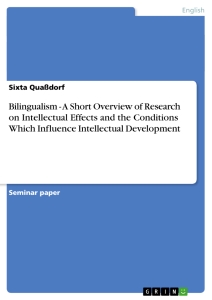From the point of view of learning psychology, bilingualism is quite positive, but it has not always been, in the 1960s it was thought to hinder the intellectual development of children, it was believed that they had to translate everything they heard and read in both languages. simultaneously, and that was a waste of time and effort.
Today, however, it is proven that far from harming learning even benefits you. The benefits of bilingualism are evident. And not only for children, but also for adults, because learning a new language slows cognitive decline.
- Some of the factors that have contributed most decisively to the rise of bilingualism are historical and cultural in nature.
- Specifically those related to the opening up and establishment of new borders between countries.
- As mentioned below:.
The relationship that develops between the mother and the baby is the prototype of the communicative exchange par excellence, for months the mother interprets the signals that her child sends her (crying, screaming, laughing, signals) and translates them into different words and intentions.
Gradually, the adult becomes the baby’s mirror. When the mother makes a sound, the baby plays it; when she gestures, he tries to imitate her. Thus, a playful exchange develops that helps the baby to gradually understand and expand the knowledge of the world.
Therefore, it is the interaction between mother and child that determines both the appearance of language and its level in the child. The types of communicative interaction between the two change and evolve as the child grows.
There are two key variables in the development of bilingualism in children, on the one hand, in the context in which it develops and on the other, the level of maturity in which the child is located, so there are two types of bilingualism :
Perfect bilingualism is quite difficult to achieve. There is always one language that is a little more developed and has more weight than the other, the more similar the mother tongue and the foreign language, the faster and more effective the learning of both.
Studies have been conducted with 6-month-old babies (Nazzi y cols, 2009) using filtering techniques to check bilingualism in early childhood. The conclusions are really surprising: at 6 months, babies are able to distinguish their mother tongue from a second language. .
This is not to say that they know how to discriminate phonetic details of language, but that they can distinguish prosodic information (intonation, rhythm?). This turns 6-month-old babies into potential polyglots; however, this ability decreases with age. , because as a result of human evolution, it disappears when it is not considered a fundamental skill for its survival.
According to Marshal, a number of social, cognitive and linguistic circumstances must be given for bilingualism to be positive for children:
According to several surveys, children who speak two languages without distinction have their most developed prefrontal and dorsolateral bark, linked to executive functions. This makes them faster and more efficient in certain tasks where these superior skills are needed.
In addition, they tend to better discriminate on stimuli in their environment and ignore class noise with some ease, making it easier for them to focus on the topic in question. They also tend to have a higher cognitive reserve, i. e. a brain control mechanism. this allows them to ‘depreciate the effects of age’ and delay their intellectual decline.
As you can see, the benefits of being multilingual are not limited to the linguistic field, having the capacity and knowledge to evolve effectively in an intercultural environment in two languages is the result of taking advantage of the adaptation opportunities offered by nature.

